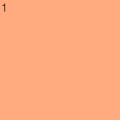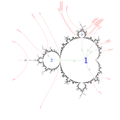Fractals/Iterations in the complex plane/Mandelbrot set interior
This book shows how to code different algorithms for drawing parameter plane[1] (Mandelbrot set[2]) for complex quadratic polynomial.[3]
One can find different types of points / sets on parameter plane.[4]
This page is about interior points of the Mandelbrot set.[5]
Interior of Mandelbrot set - hyperbolic components
[edit | edit source]The “Capture-Time” Algorithm: Iterations needed to Converge
[edit | edit source]The “capture-time algorithm” is a natural counterpart for points inside the set to the “escape-time algorithm”. Given some desired tolerance, the orbit P is generated for each point c ∈ C until some point in the orbit is closer than to some previous point in the orbit. The number of iterations needed for this to occur is mapped to a color and displayed at the pixel corresponding to c. Adam Cunningham[6]
The Lyapunov exponent
[edit | edit source]-
whole set
-
mini Mandelbrot set
-
real quadratic map
Math equation :[7]
where:
means first derivative of f with respect to z
See also:
HLSL code by JPBotelho[10]
Shader "Fractals/Coloring Techniques/Escape-Time"
{
Properties
{
_MainTex ("Texture", 2D) = "white" {}
_Iter ("Iterations", Range(0, 250)) = 100
_Dividend ("Dividend", Range (0, 0.5)) = 15
_Zoom ("Zoom", Range (0.1, 1000)) = 0.65
_Position ("Offset", Vector) = (0.4, 0, 0, 0)
_Background ("Background", Color) = (0, 0.25, 1, 0)
_Origin ("Origin", Color) = (0, 0, 0, 0)
}
SubShader
{
Cull Off ZWrite Off ZTest Always
Pass
{
CGPROGRAM
#pragma vertex vert
#pragma fragment frag
#include "UnityCG.cginc"
#include "Complex.cginc"
#include "FractalOperations.cginc"
struct appdata
{
float4 vertex : POSITION;
float2 uv : TEXCOORD0;
};
struct v2f
{
float2 uv : TEXCOORD0;
float4 vertex : SV_POSITION;
};
sampler2D _MainTex;
int _Iter;
fixed _Zoom;
fixed _Dividend;
float2 _Position;
fixed4 _Background;
fixed4 _Origin;
v2f vert (appdata v)
{
v2f o;
o.vertex = UnityObjectToClipPos(v.vertex);
o.uv = v.uv;
return o;
}
fixed4 frag (v2f i) : SV_Target
{
float x0 = (ClampScaleX(i.uv) + _Position.x) / _Zoom;
float y0 = (ClampScaleY(i.uv) + _Position.y) / _Zoom;
float2 z = float2(x0, y0);
float2 c = float2(x0, y0);
int iteration = 0;
float l = 0;
while (IsBounded(z, 40) && iteration < _Iter)
{
l += log (cabs(2 * z));
z = cmul(z, z);
z += c;
iteration++;
}
l /= iteration;
if (l > 0)
return _Background;
float3 color = tanh(l >= 0 ?
float3(0, 0.7 * log(1 + l), log(1 + l)) :
3 * float3(_Origin.x-l, _Origin.y-l * 0.1, _Origin.z));
return float4(color + _Dividend, 1);
}
ENDCG
}
}
CustomEditor "FractalEditor"
}
Interior distance estimation
[edit | edit source]
DEM/M - description of the method
absolute value of the orbit
[edit | edit source]# Hypercomputing the Mandelbrot Set? by Petrus H. Potgieter February 1, 2008
n=1000; # For an nxn grid
m=50; # Number of iterations
c=meshgrid(linspace(-2,2,n))\ # Set up grid
+i*meshgrid(linspace(2,-2,n))’;
x=zeros(n,n); # Initial value on grid
for i=1:m
x=x.^2+c; # Iterate the mapping
endfor
imagesc(min(abs(x),2.1)) # Plot monochrome, absolute
# value of 2.1 is escape
internal level sets
[edit | edit source]Color of point:
- is proportional to the value of z is at final iteration.
- shows internal level sets of periodic attractors.
bof60
[edit | edit source]Image of bof60 in on page 60 in the book "the Beauty Of Fractals".Description of the method described on page 63 of bof. It is used only for interior points of the Mandelbrot set.
Color of point is proportional to:
- the smallest distance of its orbit from origin[11][12]
- the smallest value z gets during iteration[13]
- illuminating the closest approach the iterates of the origin (critical point) make to the origin inside the set
- "Each pixel of each particular video frame represents a particular complex number c = a + ib. For each sequential frame n, the magnitude of z(c,n) := z(c, n-1)^2 + c is displayed as a grayscale intensity value at each of these points c: larger magnitude points are whiter, smaller magnitudes are darker. As n rises from 1 to 256, points outside the Mandelbrot Set quickly saturate to pure white, while points within the Mandelbrot Set oscillate through the darker intensities." Brian Gawalt[14]
Level sets of distance are sets of points with the same distance[15]
if (Iteration==IterationMax)
/* interior of Mandelbrot set = color is proportional to modulus of last iteration */
else { /* exterior of Mandelbrot set = black */
color[0]=0;
color[1]=0;
color[2]=0;
}
- fragment of code : fractint.cfrm from Gnofract4d[16]
bof60 {
init:
float mag_of_closest_point = 1e100
loop:
float zmag = |z|
if zmag < mag_of_closest_point
mag_of_closest_point = zmag
endif
final:
#index = sqrt(mag_of_closest_point) * 75.0/256.0
}
See also
- Mandelbrot Trajectory Infima by jeremy-rifkin Jeremy Rifkin
- Displaying the Internal Structure of the Mandelbrot Set by Adam Cunningham
bof61 or atom domains
[edit | edit source]- Bof61
-
animation
-
2D
-
3D
Period of hyperbolic components
[edit | edit source]
Period of hyperbolic component of Mandelbrot set is a period of limit set of critical orbit.
Algorithms for computing period:
- direct period detection from iterations of critical point z = 0.0 on dynamical plane
- "quick and dirty" algorithm : check if then colour c-point with colour n. Here n is a period of attracting orbit and eps is a radius of circle around attracting point = precision of numerical computations
- "methods based on interval arithmetic when implemented properly are capable of finding all period-n cycles for considerable large n." (ZBIGNIEW GALIAS )[17]
- Floyd's cycle-finding algorithm[18]
- the spider algorithm
- atom domain, BOF61
- Period detection
interior detection
[edit | edit source]Pixel is interior with high probability if all below is [19]
- pixel is marked as interior ( black)
- all surrounding pixels are marked as interior ( black)
- all the black pixels have the same period
internal coordinate and multiplier map
[edit | edit source]

The algorithm by Claude Heiland-Allen:
- check c
- When c is outside the Mandelbrot set
- give up now
- or use external coordinate
- when c is not outside (inside or on the boundary) : For each period p, starting from 1 and increasing:
- Find periodic point z0 such that fp(z0,c)=z0 using Newton's method in one complex variable
- Find b by evaluating first derivative with respect to z of fp at z0
- If |b|≤1 then return b, otherwise continue with the next p
- When c is outside the Mandelbrot set
computing
[edit | edit source]For periods:[23]
- 1 to 3 explicit equations can be used[24]
- >3 it must be find using numerical methods
period 1
[edit | edit source]Start with boundary equation:
c+(w/2)^2-w/2=0;
and solve it for w
(%i1) eq1:c+(w/2)^2-w/2=0;
2
w w
(%o1) -- - - + c = 0
4 2
(%i2) solve(eq1,w);
(%o2) [w = 1 - sqrt(1 - 4 c), w = sqrt(1 - 4 c) + 1]
(%i3) s:solve(eq1,w);
(%o3) [w = 1 - sqrt(1 - 4 c), w = sqrt(1 - 4 c) + 1]
(%i4) s:map(rhs,s);
(%o4) [1 - sqrt(1 - 4 c), sqrt(1 - 4 c) + 1]
so
w = w(c) = 1.0 - csqrt(1.0-4.0*c)
period 2
[edit | edit source]w = 4.0*c + 4;
period 3
[edit | edit source]
It can be solved using Maxima CAS:
(%i1) e1:c^3 + 2*c^2 - (w/8-1)*c + (w/8-1)^2 = 0;
3 2 w w 2
(%o1) c + 2 c + (1 - -) c + (- - 1) = 0
8 8
(%i2) solve(e1,w);
(%o2) [w = (- 4 sqrt((- 4 c) - 7) c) + 4 c + 8, w = 4 sqrt((- 4 c) - 7) c + 4 c + 8]
numerical approximation
[edit | edit source]complex double AproximateMultiplierMap(complex double c, int period, double eps2, double er2)
{
complex double z; // variable z
complex double zp ; // periodic point
complex double zcr = 0.0; // critical point
complex double d = 1;
int p;
// first find periodic point
zp = GivePeriodic( c, zcr, period, eps2, er2); // Find periodic point z0 such that Fp(z0,c)=z0 using Newton's method in one complex variable
// Find w by evaluating first derivative with respect to z of Fp at z0
if ( cabs2(zp)<er2) {
z = zp;
for (p=0; p < period; p++){
d = 2*z*d; /* first derivative with respect to z */
z = z*z +c ; /* complex quadratic polynomial */
}}
else d= 10000; //
return d;
}
See also:
Internal angle
[edit | edit source]
Method by Renato Fonseca :[25] "a point c in the set is given a hue equal to argument
(scaled appropriately so that we end up with a number in the range 0 - 255). The number z_nmax is the last one calculated in the z's sequence."
See also:
Fractint
[edit | edit source]Fractint : Color Parameters : INSIDE=ATAN
colors by determining the angle in degrees the last iterated value has with respect to the real axis, and using the absolute value. This feature should be used with periodicity=0[26]
Internal rays
[edit | edit source]From Hyperbolic to Parabolic Parameters along Internal Rays[27]
-
Internal and external rays
-
multiplier map and internal rays
-
internal and external rays
When varies and is constant then goes along internal ray.[28] It is used as a path inside Mandelbrot set.
double complex Give_c(double t, double r, int p)
{
/*
input:
InternalRadius = r in [0,1]
InternalAngleInTurns = t in range [0,1]
p = period
output = c = complex point of 2D parameter plane
*/
complex double w = 0.0;
complex double c = 0.0;
t = t*2*M_PI; // from turns to radians
// point of unit circle
w = r* cexp(I*t);
// map circle to component
switch (p){
case 1: c = (2.0*w - w*w)/4.0; break;
case 2: c = (w -4.0)/ 4.0; break;
}
return c;
}
/* find c in component of Mandelbrot set
uses complex type so #include <complex.h> and -lm
uses code by Wolf Jung from program Mandel
see function mndlbrot::bifurcate from mandelbrot.cpp
http://www.mndynamics.com/indexp.html
*/
double complex GiveC(double InternalAngleInTurns, double InternalRadius, unsigned int period)
{
//0 <= InternalRay<= 1
//0 <= InternalAngleInTurns <=1
double t = InternalAngleInTurns *2*M_PI; // from turns to radians
double R2 = InternalRadius * InternalRadius;
double Cx, Cy; /* C = Cx+Cy*i */
switch ( period ) {
case 1: // main cardioid
Cx = (cos(t)*InternalRadius)/2-(cos(2*t)*R2)/4;
Cy = (sin(t)*InternalRadius)/2-(sin(2*t)*R2)/4;
break;
case 2: // only one component
Cx = InternalRadius * 0.25*cos(t) - 1.0;
Cy = InternalRadius * 0.25*sin(t);
break;
// for each period there are 2^(period-1) roots.
default: // safe values
Cx = 0.0;
Cy = 0.0;
break; }
return Cx+ Cy*I;
}
// draws points to memory array data
int DrawInternalRay(double InternalAngleInTurns, unsigned int period, int iMax, unsigned char data[])
{
complex double c;
double InternalRadius;
double RadiusStep; // between radius of points
int i; // number of point to draw
RadiusStep = 1.0/iMax;
for(i=0;i<=iMax;++i){
InternalRadius = i * RadiusStep;
c = GiveC(InternalAngleInTurns, InternalRadius, period);
DrawPoint(c,data);
}
return 0;
}
Example: internal ray of angle = 1/6 of main cardioid.
Internal angle:
radius of ray:
Point of internal radius of unit circle:
Map point to parameter plane:
For this is equation for main cardioid.
Internal curve
[edit | edit source]When is constant varies and varies then goes along internal curve.
/* find c in component of Mandelbrot set
uses complex type so #include <complex.h> and -lm
uses code by Wolf Jung from program Mandel
see function mndlbrot::bifurcate from mandelbrot.cpp
http://www.mndynamics.com/indexp.html
*/
double complex GiveC(double InternalAngleInTurns, double InternalRadius, unsigned int period)
{
//0 <= InternalRay<= 1
//0 <= InternalAngleInTurns <=1
double t = InternalAngleInTurns *2*M_PI; // from turns to radians
double R2 = InternalRadius * InternalRadius;
double Cx, Cy; /* C = Cx+Cy*i */
switch ( period ) {
case 1: // main cardioid
Cx = (cos(t)*InternalRadius)/2-(cos(2*t)*R2)/4;
Cy = (sin(t)*InternalRadius)/2-(sin(2*t)*R2)/4;
break;
case 2: // only one component
Cx = InternalRadius * 0.25*cos(t) - 1.0;
Cy = InternalRadius * 0.25*sin(t);
break;
// for each period there are 2^(period-1) roots.
default: // safe values
Cx = 0.0;
Cy = 0.0;
break;
}
return Cx+ Cy*I;
}
// draws points to memory array data
int DrawInternalCurve(double InternalRadius , unsigned int period, int iMax, unsigned char data[])
{
complex double c;
double InternalAngle; // in turns = from 0.0 to 1.0
double AngleStep;
int i;
// int iMax =100;
AngleStep = 1.0/iMax;
for (i=0; i<=iMax; ++i) {
InternalAngle = i * AngleStep;
c = GiveC(InternalAngle, InternalRadius, period);
DrawPoint(c,data);
}
return 0;
}
Centers of components
[edit | edit source]More tutorials and code
[edit | edit source]
Tutorials
- in Basic see Mandelbrot Dazibao
- in Java see Evgeny Demidov
- in C see Linas Vepstas
- in C++ see Wolf Jung page,
- in Factor program by Slava Pestov
- in Gnuplot see Tutorial by T.Kawano
- in Lisp (Maxima) see:
- in Octave see wikibooks or another verion by Christopher Wellons
- How to Plot the Mandelbrot Set By Hand
- comparison of various languages:
- Computer Language Benchmarks Game : Compare the performance of ≈30 programming languages using ≈12 flawed benchmarks for 4 different combinations of OS/machine.
- rosettacode
- Fractal Benchmark in Ruby, Io, PHP, Python, Lua, Java, Perl, Applescript, TCL, ELisp, Javascript, OCaml, Ghostscript, and C by Erik Wrenholt
- in PDL, IDL, MATLAB, Octave, C and FORTRAN77 by Xavier Calbet
- ASCI graphic :[29]
- ASCII Graphics at Mu-Ency by Robert P. Munafo
- using scripting languages by Warp
- Fractal Benchmark by Theo Wollenleben
- using Lisp on Bill Clementson's blog
- 3D
-
This is a 3D version of the image "Mandel zoom 03 seehorse.jpg" DEM
-
Half 3D hypercomplex Mandelbrot Fractal. Rendered with Mandelbulber 0.80.
References
[edit | edit source]- ↑ parameter plane in wikipedia
- ↑ Mandelbrot set in wikipedia
- ↑ complex quadratic polynomial in wikipedia
- ↑ reenigne blog : mandelbrot-set-taxonomy
- ↑ Displaying the Internal Structure of the Mandelbrot Set by A Cunningham ( with python 3 program and code)
- ↑ Displaying the Internal Structure of the Mandelbrot Set by Adam Cunningham
- ↑ The logistic equation by Didier Gonze October 4, 2013
- ↑ Ljapunov Exponent and mandelbrot set by janthor
- ↑ Image by Anders Sandberg
- ↑ github repo JPBotelho: Fractal-Megacollection ( HLSL shaders for Unity)
- ↑ Fractint : Misc. Options and algorithms
- ↑ Java™ Number Cruncher: The Java Programmer's Guide to Numerical Computing By Ronald Mak
- ↑ Firefly Application Help by Terry W. Gintz
- ↑ Mandelbrot Oscillations by Brian Gawalt
- ↑ Fractint doc by Noel Giffin
- ↑ gnofract4d
- ↑ Rigorous Investigations Of Periodic Orbits In An Electronic Circuit By Means Of Interval Methods by Zbigniew Galias
- ↑ Mandelbrot set drawing by Milan
- ↑ fractalforums.org : determining-optimal-iterations-to-skip-with-series-approximation
- ↑ interior_coordinates_in_the_mandelbrot_set by Claude Heiland-Allen
- ↑ practical interior_distance rendering by Claude Heiland-Allen
- ↑ math.stackexchange question: test-for-membership-in-mandelbrot-bulb-of-period-n/1151953#1151953
- ↑ Brown Method by Robert P. Munafo, 2003 Sep 22.
- ↑ Exact Coordinates by Robert P. Munafo, 2003 Sep 22.
- ↑ The Mandelbrot set by Renato Fonseca
- ↑ fractint color params
- ↑ From Hyperbolic to Parabolic Parameters along Internal Rays by Yi-Chiuan Chen and Tomoki Kawahira
- ↑ internal ray in wikipedia
- ↑ ASCII graphic



























